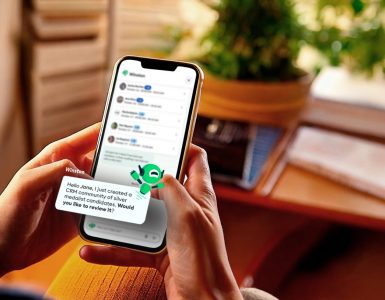If you still think of LinkedIn as an online resume for job seekers, it’s time to get real and gain the competitive edge offered by this unparalleled branding resource. LinkedIn is one of your company’s most powerful tools for building relationships with key stakeholders while amplifying and reinforcing your brand message. Its value increases exponentially when you get ALL your employees using LinkedIn to build their personal brands in support of your corporate mission.
Few companies have tapped into the full potential of LinkedIn – delivering a huge advantage to those organizations that have wisely chosen to develop a comprehensive LinkedIn program. Some managers view LinkedIn as a threat (“If my employees are on LinkedIn, they are looking for a job or making it easier for my competitors to poach them”). That mindset needs to be changed. Not only does LinkedIn help you benefit from your employees’ personal branding efforts, engaging your people in LinkedIn can translate into deeper commitment and engagement levels within your company – the better solution for a manager who is having trouble retaining good employees.
Another concern about using LinkedIn for corporate branding is that it requires solid collaboration across Marketing/Branding Communications, IT and Talent Development. The issue of “Who owns it?” is less likely to rankle upper management if a solid brand strategy is already being implemented across the company. To get the internal conversation started, here’s a link to a piece that explains how LinkedIn can make your people more valuable and your business more visible to stakeholders.
Whether you’re still encountering resistance or you’re ready to set sail with the program, the following step-by-step, proven approach shows how LinkedIn can easily be integrated into your overall branding effort. The value should be crystal clear: LinkedIn offers a great opportunity for cruising past your competitors.
Assemble the team. First, make sure you have the right people involved. As with most corporate initiatives, the program lives or dies by the people leading it. When you have the right mix of disciplines, along with a high level of enthusiasm for the project and influential leaders who are respected by those outside their functional area, you have what you need to make the program a success.
Establish a baseline. Understand who in the organization currently has a profile. Evaluate the quality of the various profiles. Record how many followers you have on your company page. Do as much as you can to understand the current situation so you can see the impact of the transformative work you’re about to do.
Identify LinkedIn stars. There are likely people in your organization who are power users of LinkedIn, regularly maximizing it to help them do their job better. Engage them in the process.
Set goals. In the initial phase, what percentage of employees do you want using LinkedIn? How much increase do you want to achieve in the “shares” of your company content? Engage your leaders throughout the organization to obtain the information you need and to set quantifiable aims. Aggregate the data so you have a company-wide picture of your starting point and your progress.
Involve your top executives. Employees should be able to look to the company’s leaders as role models. If you want your program to be successful, you need to start at the top. Make sure your leaders all have stellar profiles and are using LinkedIn as a tool to stay connected to stakeholders. For key leaders, create a scorecard that includes measures for completeness, quality and activity. The scoring process shouldn’t feel judgmental, and it might require a higher touch approach than you will be able to roll out to everyone. For anyone who needs help, be ready to share a batch of sample high-scoring profiles and case studies from the company’s leadership team.
Build a comprehensive development program. With most of my clients, I find a three-stage LinkedIn program works best:
- Profiles. This stage is about building a perfect LinkedIn profile that is authentic, compelling and high quality. Your network won’t work if your profile does not impress viewers. Your profile should make them want to get to know you.
- People. This stage has to do with connections and groups – building your network and understanding how to use LinkedIn as your contact management system.
- Performance. This final stage leads to doing your job better. Teach employees how to use LinkedIn to demonstrate their thought-leadership, solve problems, source staff, nurture their network, and open doors to clients and partners.
Integrate LinkedIn modules into all relevant talent development programs – from orientation to high-potential initiatives and executive coaching programs. For orientation, make sure to build a consistent LinkedIn module into your onboarding protocol, helping new hires get the basics. Include evidence that shows why LinkedIn is important and what your company provides in terms of support. Employees who are coming from a previous company that blocked LinkedIn will find your approach liberating – and they’ll see the wisdom in blending their personal branding efforts with your corporate brand strategy.
Continuing education is crucial for a constantly evolving tool like LinkedIn. Train-the-trainer programs are especially helpful for encouraging customization within teams. Engage leaders to keep the entire organization up-to-speed.
Measure and report progress. At appropriate intervals, look at the progress you are making toward the measures you established at the outset of the program and adjust your approach as required.
Other tips for an effective program:
Depending on the culture and size of your organization, some of these other best practices from my clients might be valuable to you.
- Build this into your employees’ objectives for the year. If you link the program to performance and compensation, employees will see how important it is to the organization.
- Make it fun. It will be a lot more effective if this doesn’t seem like another task to add to their do-list. Amp up the fun factor by creating contests, featuring and highlighting profiles that are compelling, and starting a friendly competition among various departments.
- Link it to other initiatives. These could include your corporate intranet, which likely works a lot like LinkedIn. Rather than thinking of these as separate tools, you can let them do double duty by treating them as two connected and integrated tools. When employees write their bio for your intranet, have them use that as the starting point for their LinkedIn summary.
- Use it to connect employees with each other. Distribute the list of attendees at corporate events, particularly training sessions. Add a slide or a personal call to action suggesting that people connect to each other. Have them download the LinkedIn app on their phones, enabling them to get connected in real time.
Having developed many of these programs with my clients over the past few years, I can attest to their impact. For the individual, they increase engagement, effectiveness and confidence. For the organization, they bolster the brand, increase visibility and enhance stakeholder perceptions.
Follow me on Twitter and check out my latest book, Ditch. Dare. Do! 3D Personal Branding for Executives.
This article was written by William Arruda from Forbes and was legally licensed through the NewsCred publisher network. SmartRecruiters is the hiring success platform to find and hire great people.






